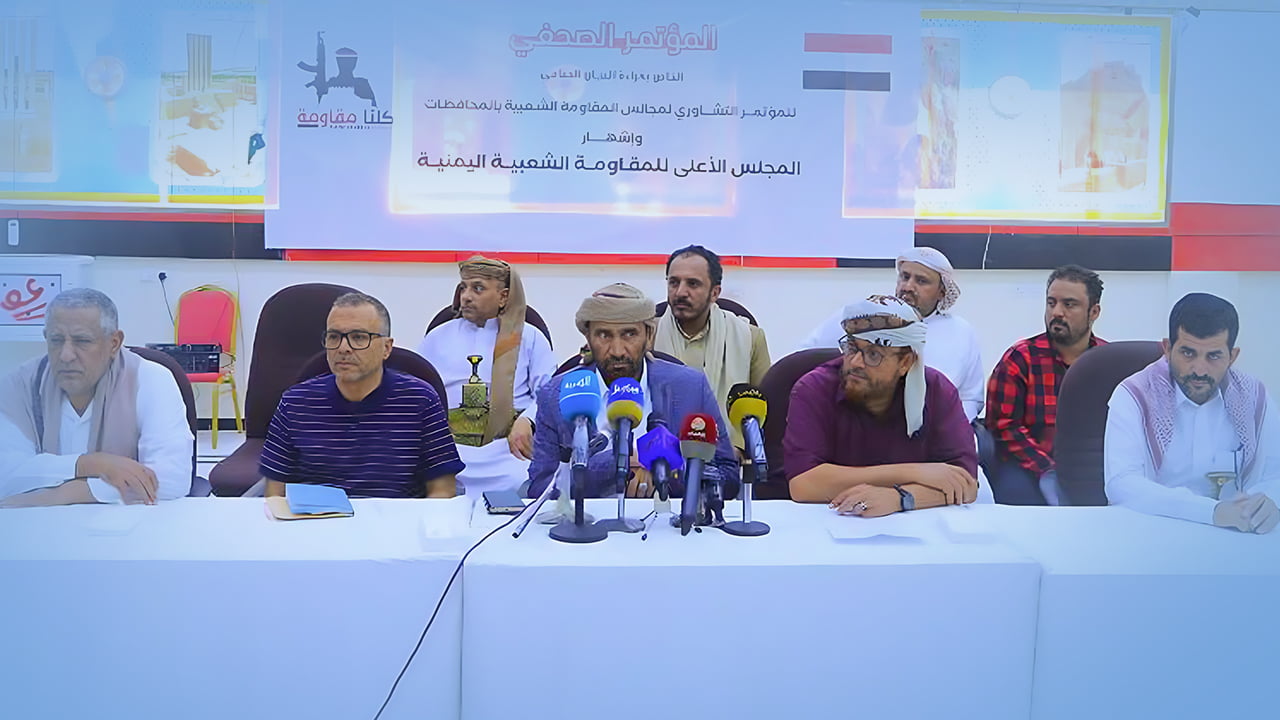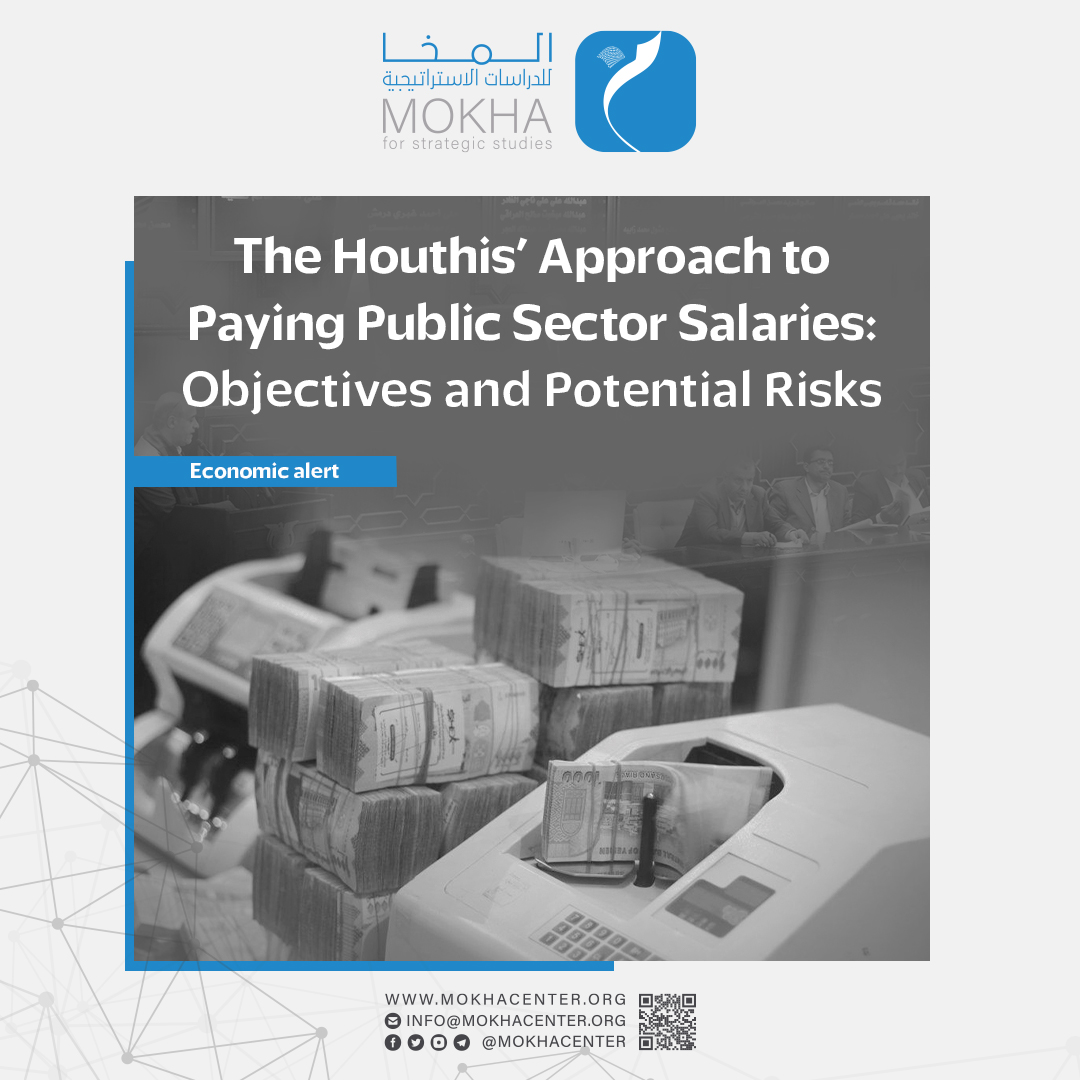Formation of the Supreme Council: A new shift in the course of the Popular Resistance in Yemen

| Getting your Trinity Audio player ready... |
During a two-day conference convened in Marib Governorate, the Yemeni governorates’ Popular Resistance councils have jointly declared the establishment of a Supreme Leadership Council. This newly formed council, led by Sheikh Hammoud Saeed Al-Mikhlafi aims to “Unifying the efforts of the Popular Resistance Councils, developing their performance and coordinating their efforts, in a way that serves the battle to restore the state and end the Houthi coup.” According to a statement issued at the end of the conference, the participants in the conference agreed on unifying all the councils of Popular Resistance in the provinces, under one entity called
The Supreme Council of Popular Resistance. (1)
This report explores the evolutionary phases and progression of the Popular Resistance, delineating its constituents and the contextual factors necessitating the establishment of its supreme council.
The emergence of Popular Resistance:
The emergence of the Popular Resistance movement in Yemen can be traced back to the social response against the Houthis’ seizure of power, which began with their takeover of the capital city, Sana’a, on September 21, 2014. This coup disrupted the democratic process and hindered the political transformation that had been progressing since the “Comprehensive National Dialogue Conference” of 2013/2014. Backed by forces loyal to former President Ali Abdullah Saleh, including elements from the military and various armed factions, the Houthi group expanded their control to other regions such as Taiz, Marib, and Aden.
This series of events compelled the Yemeni people to take up arms in defense of their nation and its sovereignty. The Houthi actions challenged the political progress achieved since the initial revolution on September 26, 1962, and the subsequent unification of Yemen on May 22, 1990. The Popular Resistance movement emerged as a response to safeguarding the state’s achievements and preserving the principles that the Yemeni society had long upheld.
Stages of development of Popular Resistance:
The development of the Popular Resistance can be outlined in various stages:
- Formation Stage in Sana’a: The initial phase began in September 2014 within the Yemeni capital, Sana’a, with the primary objective of halting the Houthi group’s advancement into the city. However, the swift collapse of the military defense apparatus of the army and armed forces hindered the Popular Resistance from effectively countering the Houthi fighters.
- Expansion to Other Governorates: As the Houthi fighters, aided by forces loyal to Saleh, extended their control towards governorates like Taiz, Ma’rib, and Al-Bayda, local branches of the Popular Resistance emerged in response. These branches were established to counter the growing influence of the Houthi group in these areas.
- Establishment in Key Governorates: Following the Houthi group’s expansion into Al-Dhalea, Lahj, and Aden, the Popular Resistance was formally established in these governorates in June 2015. Its significance gained momentum as President Hadi departed from Aden and the “Decisive Storm” military campaign, led by the Kingdom of Saudi Arabia, was initiated. This movement played a pivotal role in countering the advances made by the Houthi group and forces loyal to “Saleh,” particularly within Aden.
- Endorsement and Support: Following the successful liberation of Aden, the Popular Resistance garnered endorsement and support from President Hadi and the Arab Coalition. Their collaboration aimed to thwart what the Arab Coalition identified as Iranian influence seeping into Yemen.
- Integration into Official Forces: On July 28, 2015, the Yemeni government took the decision to assimilate members of the Popular Resistance into the country’s army and security units. This step was taken in recognition of their commendable contributions in safeguarding the nation and preserving its significant achievements. The decision was solidified after President Hadi’s meeting with the National Defense Council, during which he lauded their courageous efforts on the battlefield. Major General Abdo Al-Hudhaifi, the Yemeni Minister of Interior, further emphasized that the inclusion of Popular Resistance members into the official forces was a token of appreciation for their leadership roles across various governorates embroiled in the conflict with the militia. (2)
Components of the Popular Resistance:
- The composition of the Popular Resistance encompassed of various segments of society, regions, tribes, and political factions. The unifying factor was the shared recognition of the threat posed to their nation and homeland. As a result, the resistance’s ranks comprised:
- Tribal and social leaders.
- Intellectuals and scholars.
- Youth and university students.
- Traders and entrepreneurs.
- Soldiers and officers who opted to align with the resistance subsequent to the disintegration of the army.
- Religious scholars, advocates, and preachers.
- Workers and employees.
What prompted the Popular Resistance to take up arms?
The decision of the Popular Resistance to take up arms was triggered by a combination of national imperatives and personal motivations, including:
- Houthi Coup and Threat to National Consensus: The coup of the Houthi group, and the forces loyal to Saleh, against the state and the national consensus, and their efforts to impose their priestly perspective in governance and state administration.
- Protection of Life and Property: The Popular Resistance was formed as a response to safeguard lives and property. The Houthi group’s history of targeting Yemeni citizens through acts of violence, abuse, forced displacement, and the destruction of homes, as evident from their past conflicts with the state.
- Leadership Vacuum and Government Departure: The departure of President Hadi and his government from Aden and their subsequent absence from Yemen left a leadership vacuum. This void created an imperative for local actors to step in and safeguard the interests of the nation.
- Army Dissolution and Loyalties Split: The collapse of the army and the siding of some of its units with the former President “Saleh”, and the arrest of the Minister of Defense, Major General Mahmoud Al-Subaihi, and some of the army’s senior commanders.
Objectives of the Popular Resistance:
According to the statements and speeches issued by it during the last stage, the Popular Resistance aimed for several things, including:
- Defending state institutions, standing by the legitimacy and supporting it in the face of the coup.
- Failing the coup and restoring the political process, the democratic system and republican rule.
- Resuming the transitional period and protecting the gains of the September 26th, October 14th and February 11th revolutions.
- Protecting the unity, sovereignty and independence of Yemen and social cohesion.
Axes of Popular Resistance:
The axes of the Popular Resistance have evolved over years of conflict, with presence and activities spanning across different Yemeni governorates:
- Shifted Focus after Control Loss: Efforts for the popular resistance were formed in each of Sana’a, Amran, Saada, and Dhamar in 2014, but with the Houthi group’s complete control of these governorates, it moved to work through other governorates outside the group’s control.
- Marib Stronghold and Tribal Initiatives: The Marib resistance was formed, starting in April 2015, and hastened to establish the tribal altars, which had a major role in repelling the Houthi attacks on the governorate, fortifying Marib against their advance, and transforming Marib into a national fortress in the face of the Houthi coup. In the same year, the resistance was formed in Al-Jawf and Al-Bayda.
- Taiz as the First Line of Defense: In Taiz, the resistance was formed on April 30, 2015, under the leadership of Hammoud al-Mikhlafi; It represented the first line of defense against the Houthi group’s expansion towards the most densely populated governorate, in order to prevent it from reaching Bab al-Mandab and the city of Aden.
- Aden’s Resilient Resistance: As previously stated, a popular resistance was formed in Aden on April 26, 2015, and after two years it managed to defeat the putschists.
- Tihama Triumph and International Constraints: In the Tihama region, the resistance was formed on May 17, 2015, and it was able, with the support of the National Army and the “Coalition” forces, to defeat the Houthi group in 2018, leading to the possibility of completely liberating the city of Hodeidah, had it not been for the objection of some international parties.
Formation of the Higher Council of Popular Resistance:
On July 29, 2023, a significant milestone was reached as the Popular Resistance councils across Yemeni governorates jointly announced the establishment of a Supreme Council under the leadership of Sheikh Hammoud al-Mikhlafi.
The announcement came during a conference held in Ma’rib Governorate, with the aim of unifying the efforts of the Popular Resistance in all governorates of the Republic of Yemen, developing its performance and coordinating its efforts, in a way that serves the battle to reinstating the state and putting an end to the ongoing coup.
Dr. Abdul Hamid Amer, serving as the Vice-President of the Supreme Council for Popular Resistance, conveyed the conclusions of the conference in the closing statement. It was revealed that the conference participants unanimously agreed to unify the various councils of the popular resistance found within Yemeni governorates. This consolidation will take shape under a singular entity known as the Supreme Council for Popular Resistance. The establishment of this higher council signifies a strategic step towards forging a cohesive and coordinated front, maximizing the collective impact of the Popular Resistance in their pursuit of reinstating governmental authority and terminating the ongoing coup.
The publicity statement stated that the Supreme Council consists of representatives of the regions, representatives of the resistance councils in the governorates, in addition to the advisory committee; and that it will complete the formation of its executive bodies, committees, and specialized offices in its first scheduled meeting, and that it represents the highest authority in the resistance, and a legitimate representative of the resistance, and is entrusted with electing the supreme leadership, approving the basic statute and regulations of the resistance, and its directions, policies, and strategies.
In the press conference, the names of the supreme leadership of the Supreme Council of Popular Resistance were announced, which were agreed upon and ratified, and included personalities from several Yemeni governorates, and they are:
- Sheikh/ Hammoud Saeed Al-Mikhlafi (Taiz) Chairman.
- Dr. Abdul Hameed Muhammad Amer (Al-Jouf), Vice President for Provincial Affairs and Resistance.
- Sheikh / Muhammad Ahmad Waraq (Al-Hodeidah), Vice President for Humanitarian Affairs and Rights.
- Sheikh / Abdul Raqeeb Al-Subaihi (Lahj), Vice President for Media Affairs.
- Mr. Ramzi Mahrous (Socotra), Vice President for Services and Resources.
- Sheikh / Shawqi Muhammad Al-Sanhani (Imran), Vice President for Political Affairs and Relations. (table)
The conference also read the document of the political programme, principles and commitments that set out the most important goals and policies of the Council.
Reasons for forming the “Higher Council” of the Resistance:
The announcement of the Supreme Council for the resistance comes in several contexts, including the marginalization and weakening of the national army, and the building of military and security formations outside the state structure; diluting the legitimate authority and disabling its constitutional institutions, foremost of which is the legislative authority; The general blockage in the political and military scene in Yemen and the continuation and expansion of popular suffering; and the failure of the Houthi group to respond to calls for calm and peace efforts made by international mediators; And the recent Saudi openness to the Houthi group and making many concessions to it.
The publicity statement referred to the reasons that prompted the formation of the council, summarizing them as follows:
1- The continuation of the Houthi coup as an existential threat to the Yemeni state and identity, and the catastrophic consequences of the survival of this coup, which strike Yemen’s unity, sovereignty and territorial integrity.
2- The continuous changes in the political and military scene, the major shifts on the ground, and the facilities obtained by the coup militias from restarting the port of Hodeidah and Sana’a International Airport and lifting restrictions on the movement of militia leaders and cadres.
3- The challenges facing the legitimate authority.
4- Retreating the battle to restore the state from the list of priorities, and what this means in terms of risks threatening the future of Yemen as a state, land and people.
The most prominent general lines in the declaration of the Supreme Council of Resistance
The declaration of the Supreme Council of Resistance highlighted several fundamental principles and commitments, organized into 18 key points, among which are:
- National Struggle Principle: The Council is unwavering in its commitment to fostering a national struggle that encompasses all political and societal factions. It aims to transcend political tensions and partisan divisions, creating a united movement.
- Respect for Key References: The Gulf initiative, outcomes of the national dialogue, and UN Resolution 2216. These references are to be upheld, implemented, and not bypassed in any manner.
- Upholding Republican Values: The Council firmly adheres to the principles of a republican system of governance, a federal state structure, political and partisan diversity, and the peaceful transition of authority.
- Protection of Yemen’s Sovereignty and Unity: The Council is resolute in safeguarding Yemen’s sovereignty, unity, and territorial integrity against any threats.
- Supporting the National Army: The Council actively supports the national army in its pursuit to reinstate the state. It commits to providing assistance through all available means to fortify its endeavors.
- Strengthening Legitimate Institutions: The Council stands behind initiatives aimed at augmenting the presence of legitimate state institutions. This involves bolstering their reputation, enhancing performance, and enabling them to fulfill their duties throughout Yemen, notably leading the liberation efforts. Additionally, the Council emphasizes comprehensive care for the families of martyrs and the wounded.
- Sovereign Resource Restoration: The Council champions the right of the Yemeni state to regain control over its sovereign resources. It underscores the importance of intensifying efforts to uplift economic conditions and alleviate the suffering of the Yemeni populace.
- Securing Maritime Passages: The Council extends its support to the legitimate state’s efforts in ensuring the security of Yemeni waterways. The aim is to maintain stability in the Red Sea and the Arabian Sea.
- Positive Diplomatic Relationships: The Council is committed to fostering positive relations with nations within the Arab coalition, particularly emphasizing the Kingdom of Saudi Arabia, as well as other friendly countries. This commitment is rooted in shared values of restoring Yemen’s sovereignty, unity, and national integrity.
- Rejecting Extremism and Terrorism: The Council categorically denounces all forms of extremism, terrorism, and projects driven by dynastic, sectarian, territorial, or regional agendas. It actively strives to enhance societal unity, religious tolerance, and social harmony.
- Championing Equal Citizenship and Rule of Law
- Respecting Human Rights and Fundamental Freedoms
References:
- The inauguration of a higher leadership council for the popular resistance in Yemen, Anadolu Agency, on 7/30/2023, available at the following link: https://cutt.us/Bd7VX
- The Yemeni authorities approve the inclusion of the popular resistance in the army and security units, Xinhua, China, 7/29/2015, available at the following link: http://arabic.news.cn/2015-07/29/c_134456551.htm
- Statement publicizing the Supreme Council for the Yemeni Popular Resistance, Akhbar Al-Youm, on: 7/29/2023, available at the following link:
https://akhbaralyom.net/news_details.php?sid=163344



